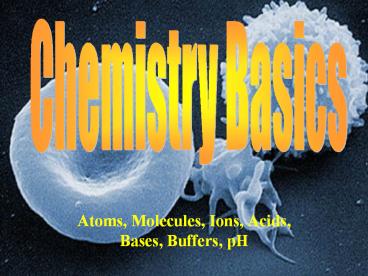Atoms, Molecules, Ions, Acids, Bases, Buffers, pH - PowerPoint PPT Presentation
Title:
Atoms, Molecules, Ions, Acids, Bases, Buffers, pH
Description:
Atoms, Molecules, Ions, Acids, Bases, Buffers, pH General Chemistry Terms See pgs. 26-41 Chemistry: Science that deals with structure of matter Refers to the ... – PowerPoint PPT presentation
Number of Views:291
Avg rating:3.0/5.0
Title: Atoms, Molecules, Ions, Acids, Bases, Buffers, pH
1
Chemistry Basics
- Atoms, Molecules, Ions, Acids, Bases, Buffers, pH
2
General Chemistry Terms
- See pgs. 26-41
- Chemistry
- Science that deals with structure of matter
- Refers to the physiology side of this class
- Matter 3 types (solid, liquid and gas)
3
Atoms
- Atom
- Smallest stable
unit of
matter - Three subatomic
particles - Protons
- Neutrons
- Electrons
4
Atoms (continued)
- Can you calculate the number of protons, neutrons
and electrons for ANY element on the periodic
table? - REMEMBER
- Protons Atomic
- Electrons of protons
- Neutrons Atomic Mass minus Atomic
- If protons are not equal to electrons the atom is
now known as an ion - Cation () and Anion (-)
5
Chemical Bonds
- Remember how to bond various atoms with other
atoms???? - The bonding capability is based on the Group
Number found at the top of each of the columns on
the periodic table - REVIEW the charges
associated with each
group. Remember that
the 8th group is the
most STABLE
6
Chemical Bonds (continued)
- Three types of chemical bonds
- Ionic bonds between ions
- Covalent bonds shared electrons
- Hydrogen bonds between two molecules
7
Inorganic Compounds
- Nutrients essential elements and molecules
normally obtained through diet - Metabolites all molecules that can be processed
and broken down by chemical reactions in our
bodies - Organic compounds
- C and H form basis
- Inorganic compounds
- Usually do NOT contain C and H atoms as primary
structure - Most important in body
- Carbon dioxide (CO2)
- Oxygen (O2)
- Water (H2O)
- Inorganic acids, bases and salts
8
Inorganic Compounds (continued)
- Water accounts for most of your body
weight. - Proteins, the key structural and functional
components of cells, and nucleic acids, which
control cell structure and function, work only in
solution with the UNIVERSAL Solvent known as
Dihydrogen oxide (water).
9
Acid/Base Terminology and the pH (parts per
Hydrogen) Scale
- Hydrogen ions (H) Chemical Bad Boy
- Highly reactive
- Break chemical bonds
- Change shape of complex molecules
- Disrupt cell and tissue functions
- Must be regulated precisely
- pH concentration of H ions in body fluids
- pH Scale 0-14
- Neutral solution with pH of 7
- Acidic solution with pH below 7
- Basic solution with pH above 7
pH of pure water 7 pH of blood 7.35-7.45
10
Blood pH
- pH of blood 7.35-7.45
- QUICK QUIZ So is blood neutral, acidic or
basic? - Basic or otherwise known as ALKALINE!
- Large changes in pH of blood can be damaging to
cells, tissues and functioning - Acidosis low blood pH (below 7.35)
- Below 7 coma
- Alkalosis high blood pH (above 7.45)
- Above 7.8 uncontrollable, sustained skeletal
muscle contractions
11
Acids, Bases and Buffersoh my!
- Acid proton donor
- Solute that releases H ions in solution
- Lowers pH of solution
- Example HCl hydrochloric acid in stomach to
break down food - Base proton acceptor
- Solute that removes H ions from solution
- Example NaOH sodium hydroxide Drano, lye
- Buffer
- Compounds that stabilize pH of a solution by
removing or replacing H ions - Weak acids and bases
- Help maintain pH of body fluids within normal
limits - Example Antacid (Alka-Seltzer) NaHCO3 (sodium
bicarbonate, baking soda)
12
BIOCHEMISTRY
- Living things are mainly composed of four kinds
of MACROMOLECULES Proteins, Nucleic Acids,
Carbohydrates and Lipids.
13
PROTEINS
- Structurally helps build certain areas of the
body that need extra toughness or strength such
as Keratin in nails and hair or cartilage. - Chemical messengers to keep the
brain in contact with the rest of the
body.
14
NUCLEIC ACIDS
- Stores information and considered the bodys
blueprint. - Comes in two varieties, DNA or RNA
15
Carbohydrates
- Provide energy storage
- Simple carbs are known as monosaccharides or
sugars - Complex carbs are known as polysaccharides
or starches - Composed of
Carbon and
Water.
16
LIPIDS
- Long term storage otherwise known as fat
- Composed of fatty acids and glycerol
- Saturated fat has single carbon bonding
- Unsaturated fat
- has double bonded
- carbons
17
THE END































